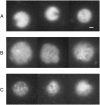Internal structure and dynamics of isolated Escherichia coli nucleoids assessed by fluorescence correlation spectroscopy
- PMID: 17259281
- PMCID: PMC1831688
- DOI: 10.1529/biophysj.106.095729
Internal structure and dynamics of isolated Escherichia coli nucleoids assessed by fluorescence correlation spectroscopy
Abstract
The morphology and dynamics of DNA in a bacterial nucleoid affects the kinetics of such major processes as DNA replication, gene expression. and chromosome segregation. In this work, we have applied fluorescence correlation spectroscopy to assess the structure and internal dynamics of isolated Escherichia coli nucleoids. We show that structural information can be extracted from the amplitude of fluorescence correlation spectroscopy correlation functions of randomly labeled nucleoids. Based on the developed formalism we estimate the characteristic size of nucleoid structural units for native, relaxed, and positively supercoiled nucleoids. The degree of supercoiling was varied using the intercalating agent chloroquine and evaluated from fluorescence microscopy images. The relaxation of superhelicity was accompanied by 15-fold decrease in the length of nucleoid units (from approximately 50 kbp to approximately 3 kbp).
Figures




Similar articles
-
The bacterial nucleoid visualized by fluorescence microscopy of cells lysed within agarose: comparison of Escherichia coli and spirochetes of the genus Borrelia.J Bacteriol. 1997 Apr;179(7):2228-37. doi: 10.1128/jb.179.7.2228-2237.1997. J Bacteriol. 1997. PMID: 9079908 Free PMC article.
-
Multiple restraints to the unfolding of spermidine nucleoids from Escherichia coli.J Struct Biol. 2000 Oct;132(1):46-62. doi: 10.1006/jsbi.2000.4306. J Struct Biol. 2000. PMID: 11121306
-
Cooperative transitions of isolated Escherichia coli nucleoids: implications for the nucleoid as a cellular phase.J Struct Biol. 2006 Feb;153(2):160-75. doi: 10.1016/j.jsb.2005.10.011. Epub 2005 Dec 9. J Struct Biol. 2006. PMID: 16384714
-
Functional consequences of improved structural information on bacterial nucleoids.Res Microbiol. 1991 Feb-Apr;142(2-3):229-38. doi: 10.1016/0923-2508(91)90035-9. Res Microbiol. 1991. PMID: 1925022 Review.
-
Pervasive regulation of nucleoid structure and function by nucleoid-associated proteins.Curr Opin Microbiol. 2011 Apr;14(2):136-41. doi: 10.1016/j.mib.2011.01.003. Epub 2011 Jan 31. Curr Opin Microbiol. 2011. PMID: 21288763 Review.
Cited by
-
The role of MatP, ZapA and ZapB in chromosomal organization and dynamics in Escherichia coli.Nucleic Acids Res. 2016 Feb 18;44(3):1216-26. doi: 10.1093/nar/gkv1484. Epub 2016 Jan 13. Nucleic Acids Res. 2016. PMID: 26762981 Free PMC article.
-
The effects of polydisperse crowders on the compaction of the Escherichia coli nucleoid.Mol Microbiol. 2020 May;113(5):1022-1037. doi: 10.1111/mmi.14467. Epub 2020 Feb 5. Mol Microbiol. 2020. PMID: 31961016 Free PMC article.
-
Diffusion within the cytoplasm: a mesoscale model of interacting macromolecules.Biophys J. 2014 Dec 2;107(11):2579-91. doi: 10.1016/j.bpj.2014.09.043. Epub 2014 Dec 2. Biophys J. 2014. PMID: 25468337 Free PMC article.
-
Differentiating the roles of proteins and polysomes in nucleoid size homeostasis in Escherichia coli.Biophys J. 2024 Jun 4;123(11):1435-1448. doi: 10.1016/j.bpj.2023.11.010. Epub 2023 Nov 16. Biophys J. 2024. PMID: 37974398 Free PMC article.
-
Simulating the entropic collapse of coarse-grained chromosomes.Biophys J. 2015 Feb 17;108(4):810-820. doi: 10.1016/j.bpj.2014.11.3487. Biophys J. 2015. PMID: 25692586 Free PMC article.
References
-
- Pettijohn, D. E. 1996. The nucleoid. In Escherichia coli and Salmonella: Cellular and Molecular Biology, Vol. II. F. C. Neidhardt, R. Curtis, C. Gross, J. Ingraham, E. C. Lin, K. B. Low, B. Magasanik, W. S. Reznikoff, M. Riley, M. Schaechter, and H. E. Umbarger, editors. ASM, Washington, DC.
-
- Hansen, J. C. 2002. Conformational dynamics of the chromatin fiber in solution: determinants, mechanisms, and functions. Annu. Rev. Biophys. Biomol. Struct. 31:361–392. - PubMed
-
- Cunha, S., T. Odijk, E. Suleymanoglu, and C. L. Woldringh. 2001. Isolation of the Escherichia coli nucleoid. Biochimie. 83:149–154. - PubMed
-
- Kavenoff, R., and O. A. Ryder. 1976. Electron microscopy of membrane-associated folded chromosomes of Escherichia coli. Chromosoma. 55:13–25. - PubMed
Publication types
MeSH terms
Substances
LinkOut - more resources
Full Text Sources

